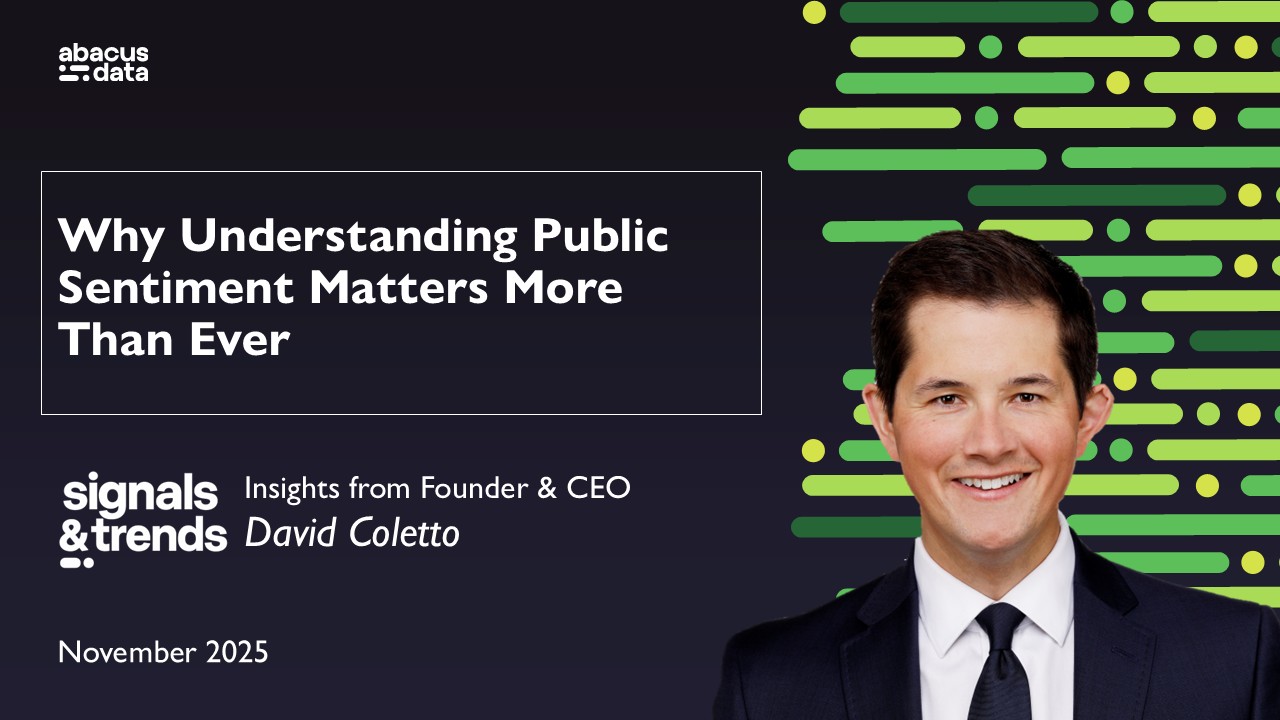Abacus Data Poll: Conservatives Edge Ahead as Cost of Living Dominates and Trump Fades
August 24, 2025
From August 15 to 19, 2025, Abacus Data surveyed 1,915 Canadian adults on the state of federal politics. The poll captures public opinion just as Air Canada flight attendants initiated strike action but it’s important to note that many of the interviews were completed prior to that event, and thus this wave does not fully reflect its impact. The same is true for Pierre Poilievre’s byelection victory on Monday.
What the data does show is a modest but meaningful shift: the Conservative Party has pulled slightly ahead in national vote intention for the first time in months. Meanwhile, the issue landscape remains anchored in affordability, with Donald Trump fading as a top-tier concern, a notable shift in a summer that’s otherwise seen stability in attitudes.
Despite these changes, government approval remains relatively steady, though with signs of erosion around economic management. The political weather hasn’t turned, but the winds may be shifting.
Direction of the Country: Steady Concern, No Escalation
Just over a third of Canadians (35%) believe the country is headed in the right direction, essentially unchanged from early August. Meanwhile, 47% say things are on the wrong track. Views of the global outlook (14% right direction) and of the United States (13%) remain bleak, driven by persistent global uncertainty and lingering wariness toward U.S. leadership.
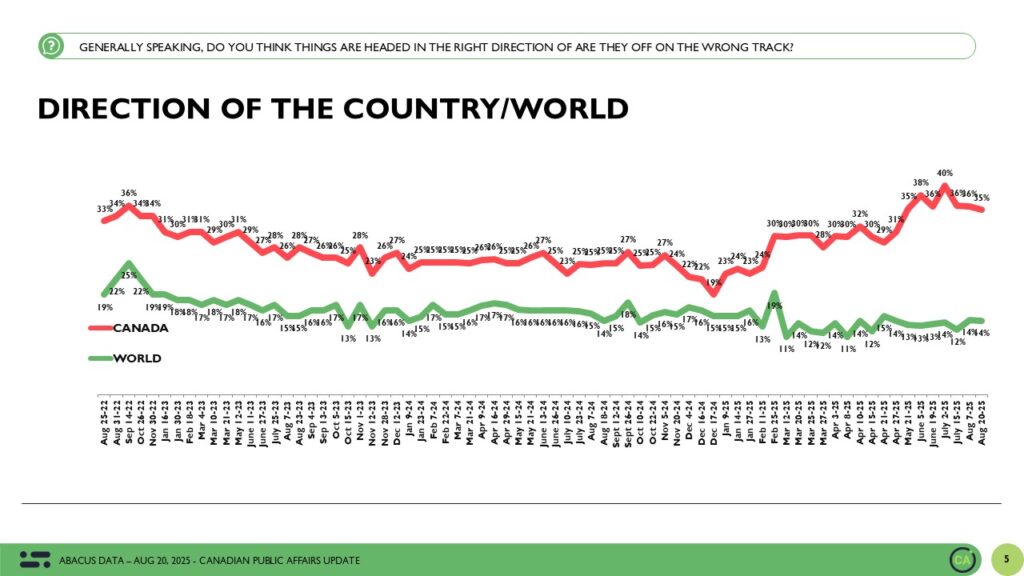

Top Issues: Trump Recedes, Affordability Remains King
The rising cost of living continues to dominate the political conversation chosen by 60% of Canadians as one of their top three concerns. The broader economy follows at 36%, and housing at 35%. Healthcare ranks fourth at 33%.
Donald Trump’s influence as a political issue appears to be diminishing. Mentioned by 38% this wave and down from 44% earlier in the summer, Trump now sits behind cost of living and is tied with the economy in salience. While still significant, his shadow is receding slightly, likely reflecting both Canadian fatigue and a slight cooling in U.S. news coverage.
Immigration remains in the middle of the pack, cited by 25%, and continues to be more polarizing than broadly resonant.
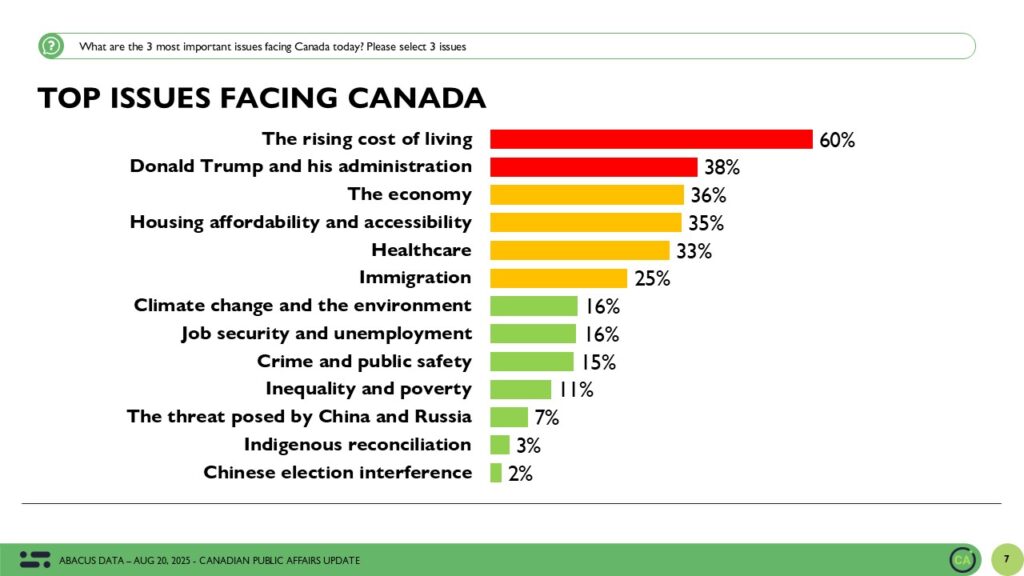
Government Approval: Still Solid, But Signs of Softness
Approval of the Carney-led federal government stands at 49%, down a point from two weeks ago and below the 50% threshold for the first time since March. Disapproval has edged up to 30%.
While these figures are still relatively strong, they point to gradual softening. The government retains majority support, but the cost of living crunch and continued frustrations around housing may be beginning to wear on that goodwill.
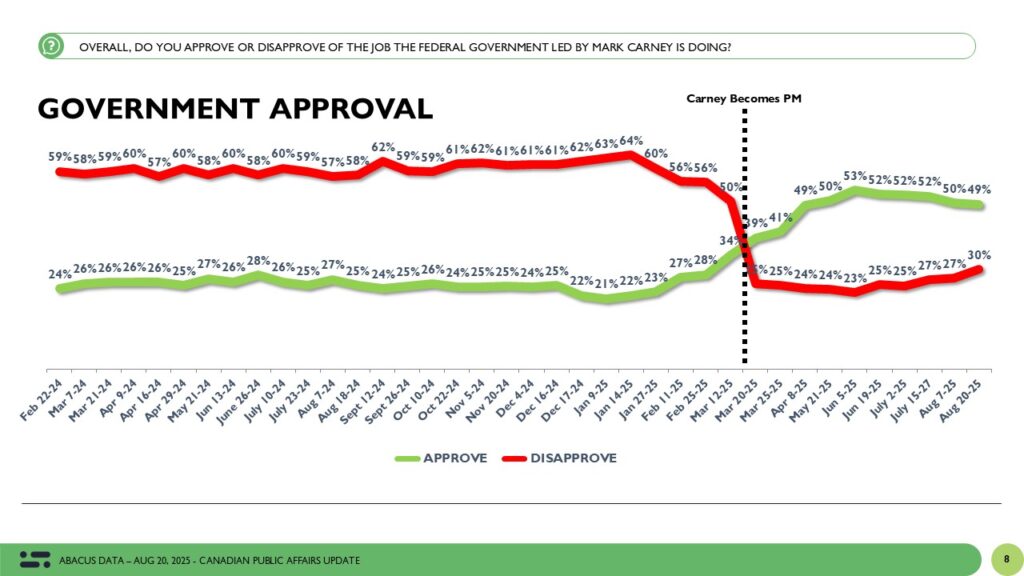
Leader Impressions: Carney Holds Steady, Poilievre Competitive
Mark Carney remains in net positive territory, with 48% viewing him favourably and 30% unfavourably, for a net score of +18 mostly unchanged since the election. His numbers remain strongest in Quebec (+28), Ontario (+20), and B.C. (+20), and among Baby Boomers (+29) and higher income Canadians.
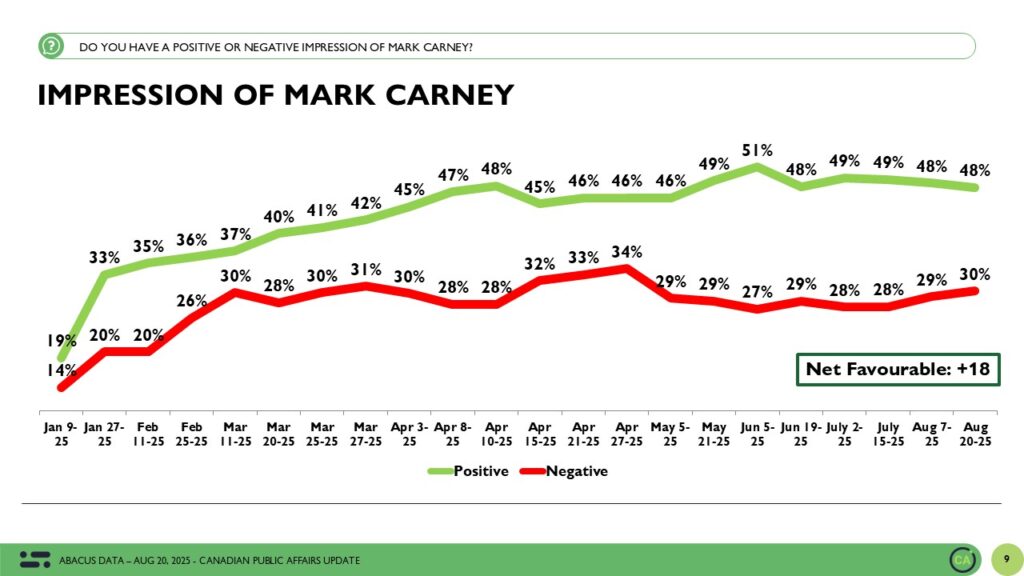
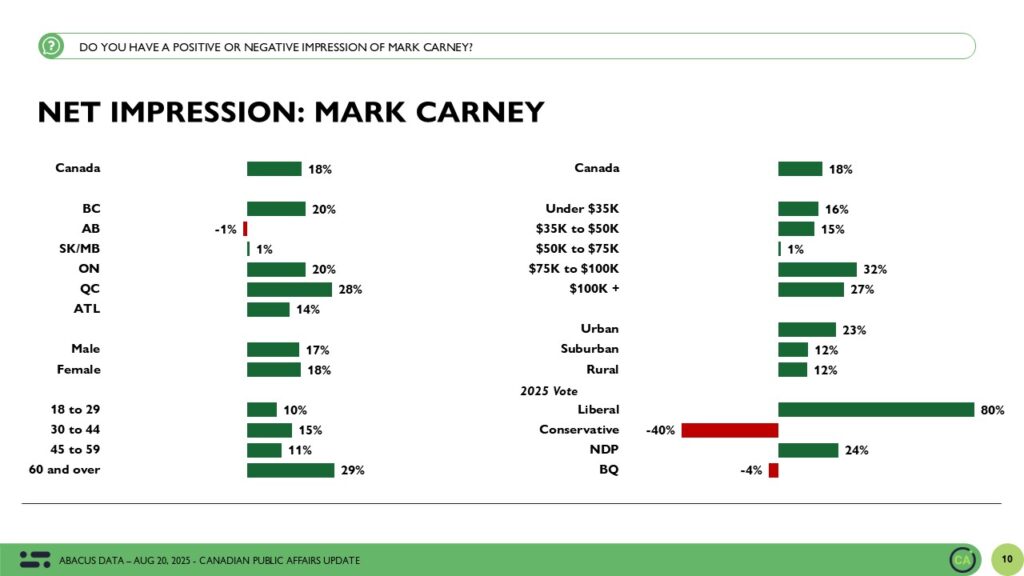
Pierre Poilievre, meanwhile, is holding competitive ground. His favourables (40%) are two points behind his unfavourables (42%), for a net rating of -2. While underwater, this is consistent with his numbers over the past few months and signals consistency in views towards him. Poilievre’s net favourables are higher among younger Canadians and men and lower among older Canadians and women.
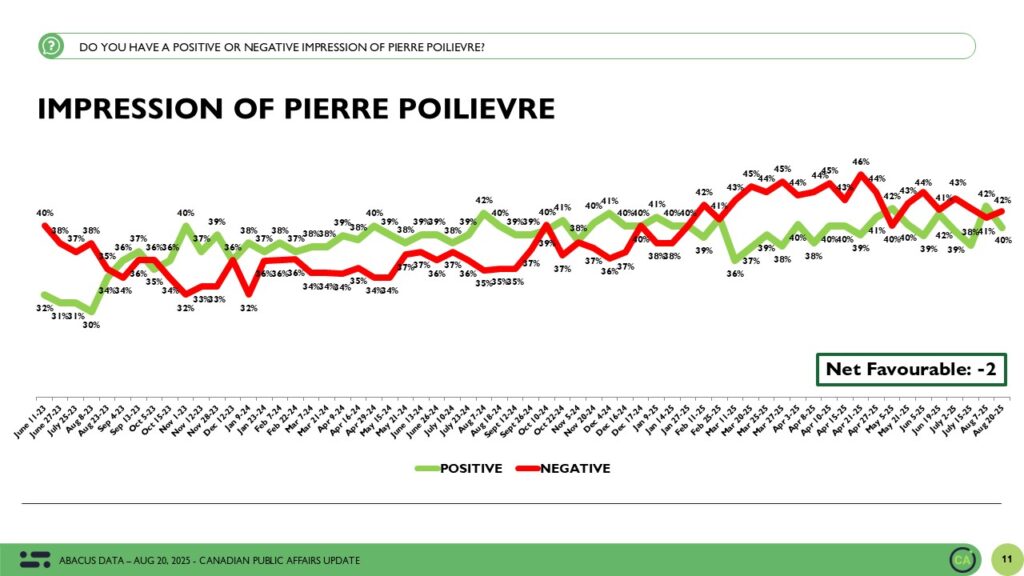
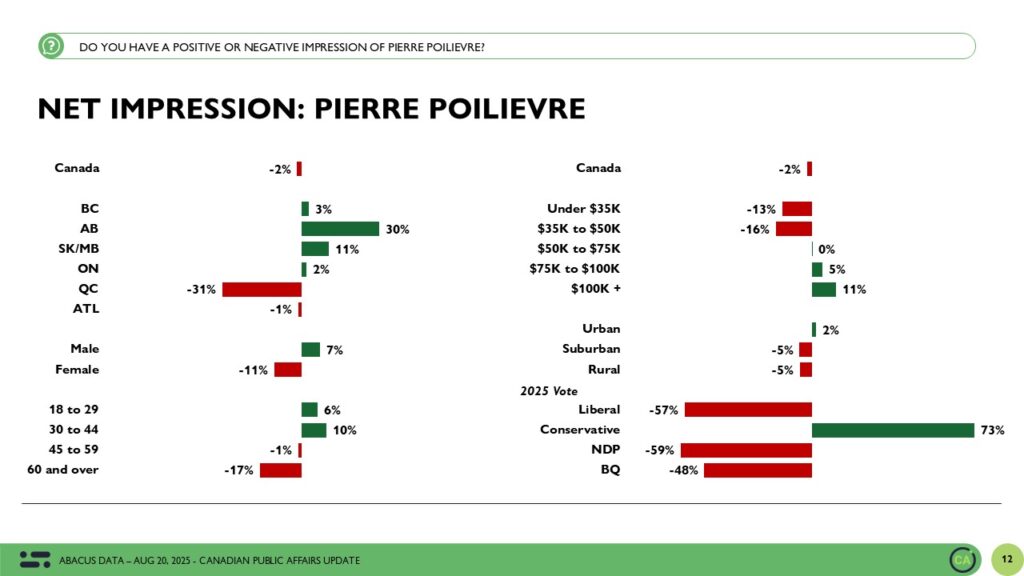

Donald Trump remains deeply unpopular in Canada: just 13% view him favourably, with 74% unfavourable, for a net score of -61.
Desire for Change: High, but Not Accelerating
Two-thirds of Canadians (66%) say it’s time for change: 36% believe there is a good alternative, and another 30% want change but aren’t sure there’s a viable option. Meanwhile, 34% still believe the Liberals under Carney deserve re-election down four points since June.
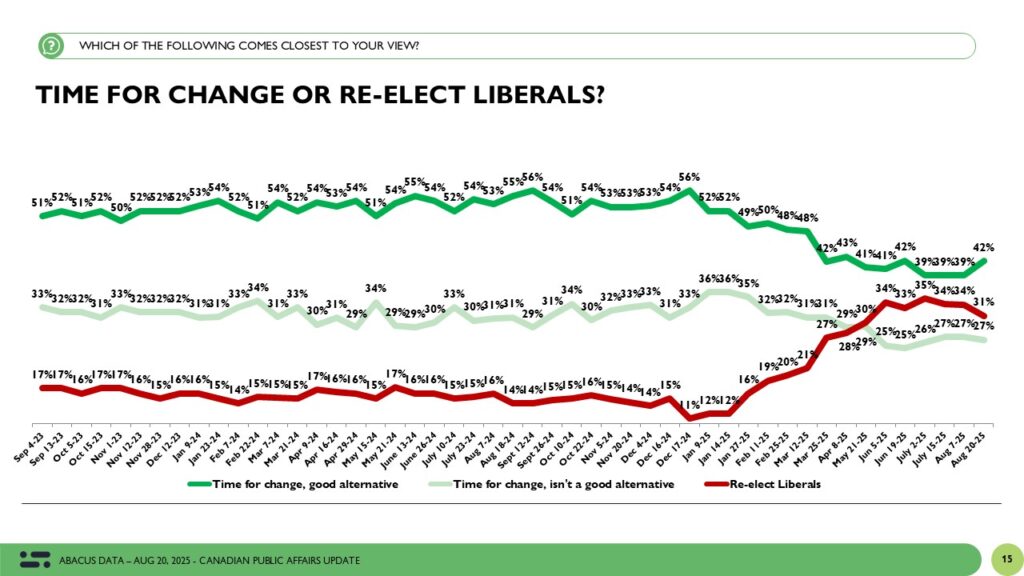
Issue Ownership: Conservatives Gain on Key Files
When Canadians are asked which party is best equipped to handle the issues they personally care most about, a clear pattern emerges:
Cost of living: Conservatives lead (39%) over the Liberals (27%)
The economy: Conservatives lead (45%) vs. Liberals (34%)
Immigration: Conservatives dominate — 56% to the Liberals’ 15%
On these core affordability and economic issues, the Conservatives are building and maintaining leads.
However, the Liberals continue to dominate on other fronts:
Climate change: Liberals lead (37%) vs. Conservatives (9%)
Donald Trump & his administration: Liberals are still the preferred party (56% vs. 21%), but fewer people list it as a top issue now.
The result is a split map, but the issues rising in salience increasingly favour the Conservatives.
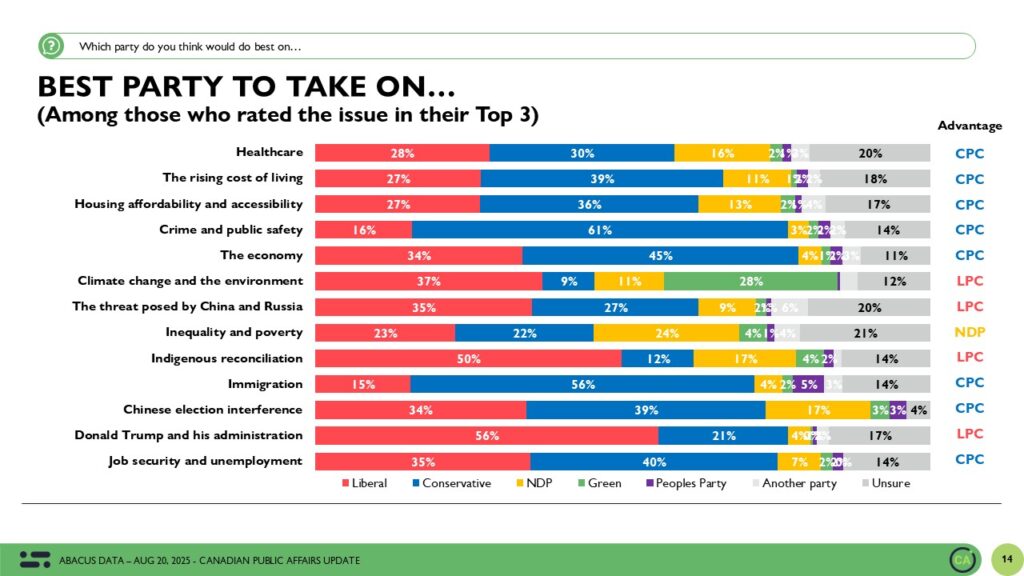
Accessible Voter Pools: Still a Close Contest
The accessible universe for the Liberal Party sits at 55%, virtually unchanged. The Conservatives follow closely at 53%, holding firm. Regionally, Liberals lead in Ontario and Quebec, while the Conservatives dominate in the West. The NDP remains in third, with 35% saying they would consider voting for the party, unchanged since the election.
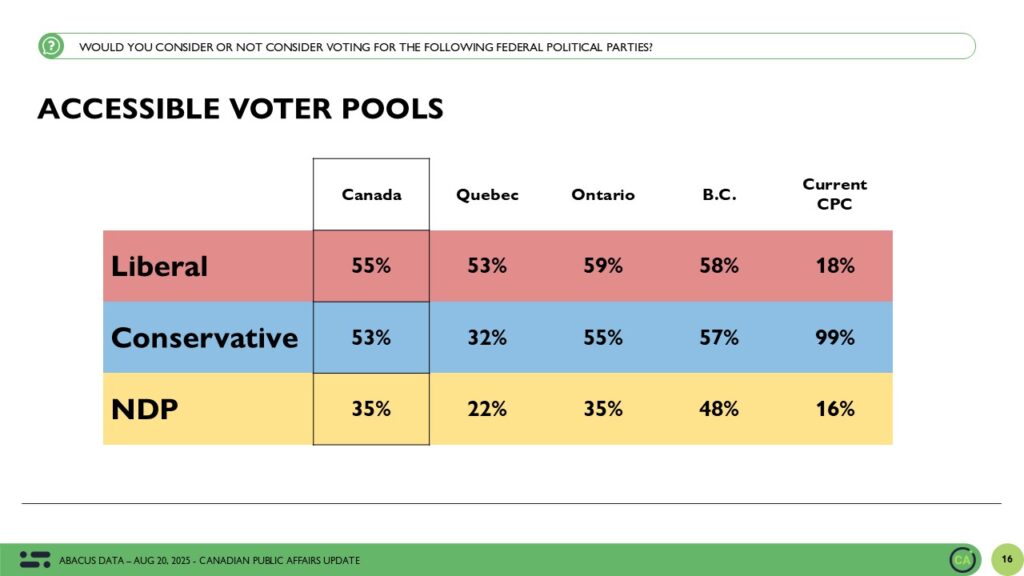
Vote Intention: Conservatives Take the Lead
If an election were held today, 41% of decided voters would cast a ballot for the Conservatives, up one point. The Liberals sit at 39%, down four points since early August. The NDP holds at 7%, Bloc at 7%, Greens at 2%, and PPC at 2%.
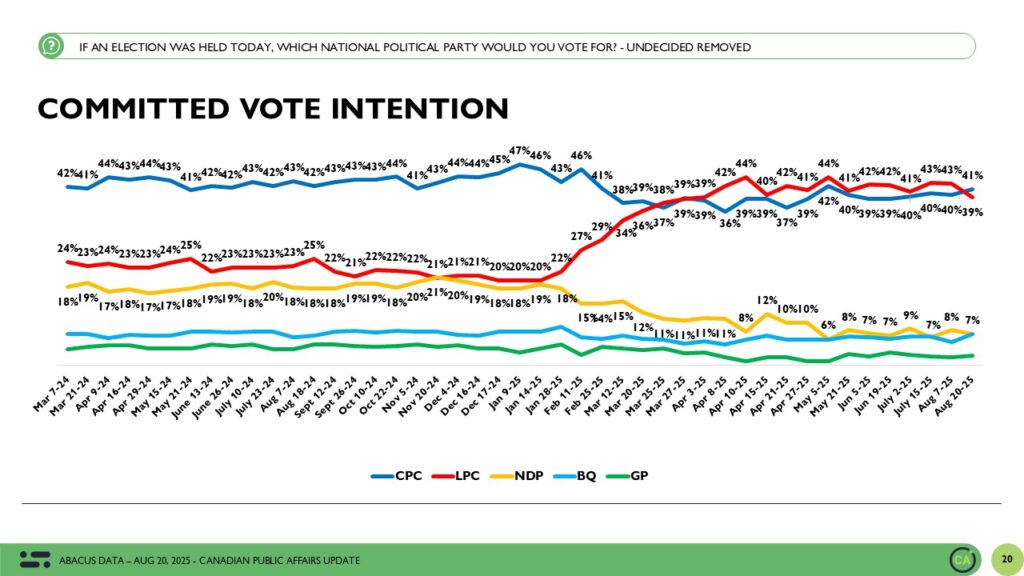
Among those certain to vote, it’s a dead heat: 41% Liberal, 41% Conservative suggesting the gap may close in a turnout scenario thanks in part to the Liberal lead among older voters.
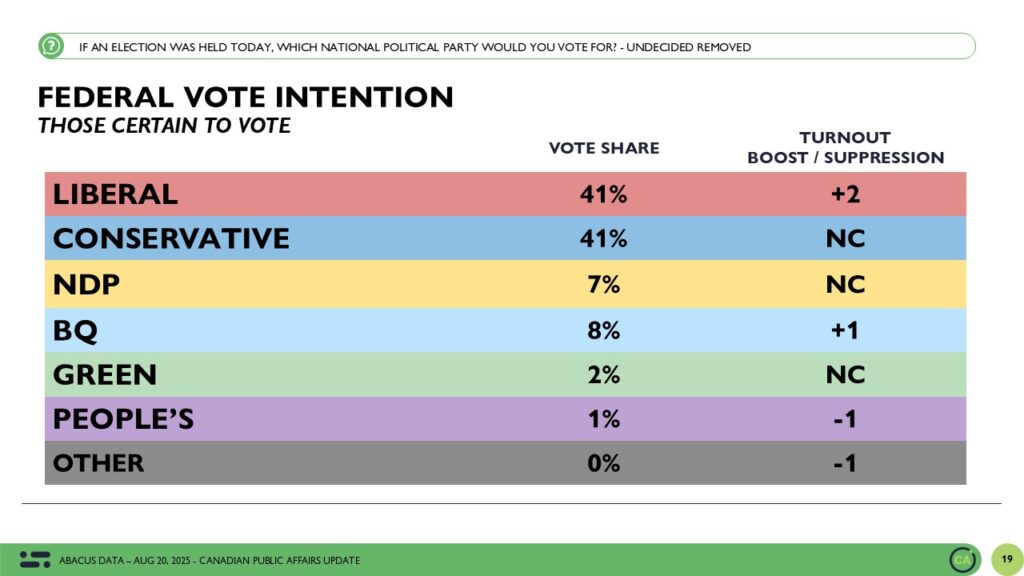
Regional Snapshot:
British Columbia: Conservatives and Liberals statistically tied (43% to 42%)
Ontario: Liberals are marginally ahead 46% to 44%
Quebec: Liberals lead with 40%, Bloc at 36%, CPC at 21%
Atlantic Canada: Liberals and Conservatives statistically tied (43% to 42%)
Alberta: CPC continues to dominate (62% to Liberals’ 26%)
Saskatchewan/Manitoba: Conservatives strong at 52%, Liberals at 35%
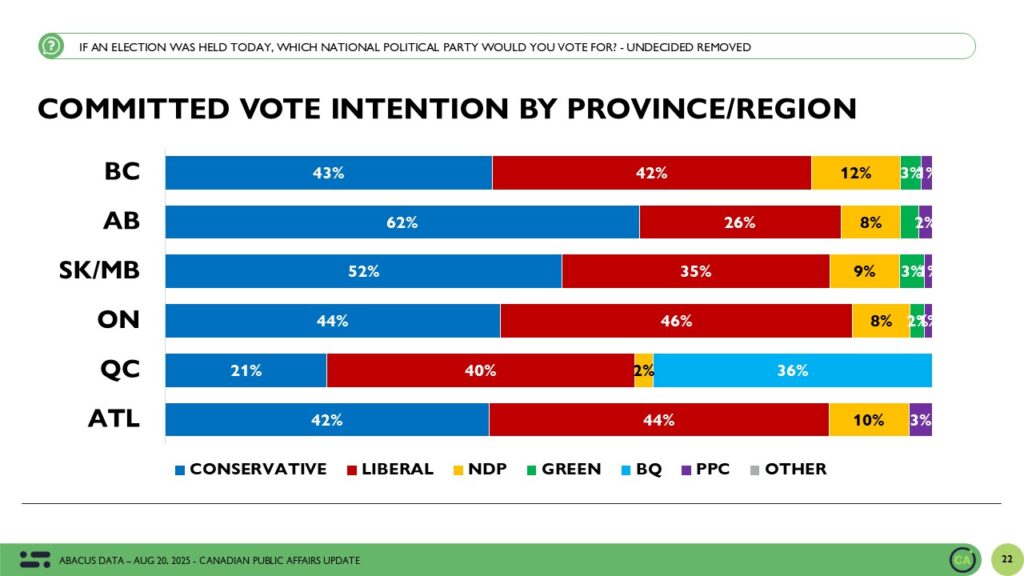
Demographic Trends: Familiar Divides Remain
We see a closing of generational gaps in the data. The Liberals and Conservatives are statistically tied among all age groups except for those aged 45 to 59 who the Conservatives lead by 6. The Liberals lead by 8 among women while the Conservatives lead by 8 among men.
The Liberals lead by 18 among those with a university degree while the Conservatives lead by 10 among those with a college degree and by 7 among those with high school or less.
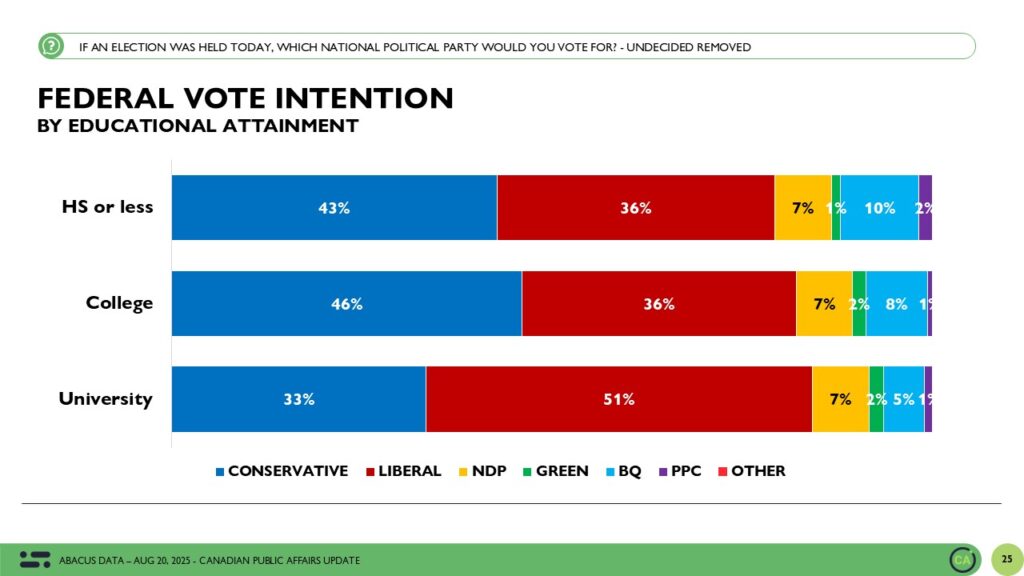

The Upshot
According to Abacus Data CEO David Coletto: “After a spring and summer of stability in public opinion, we may be seeing signs of fluidity in federal politics. The Carney government still enjoys a solid approval rating, Prime Minister Carney personally remains well liked, and the Liberal brand remains broadly accessible but public concern around affordability is persistent, and the Conservatives are clearly benefiting from that focus.
What’s notable this wave is that Donald Trump’s influence on Canadian political attitudes may be receding for now, allowing domestic issues to reassert dominance. That’s not good news for the governing party, which holds strength internationally but continues to face trust gaps on the economy, housing, and cost of living.
And for those who believe Pierre Poilievre can’t become Prime Minister: the data doesn’t support that view. The issue set remains an asset to the Conservatives, his favourability numbers are not better than Carney’s but not bad either, and the Conservative coalition remains firm. With Poilievre back in the House of Commons this fall and with a complex set of issues in front of the government, we may start to see more shifts in public opinion.”

Methodology
The survey was conducted with 1,915 Canadians from August 15 to 19, 2025. A random sample of panelists were invited to complete the survey from a set of partner panels based on the Lucid exchange platform. These partners are typically double opt-in survey panels, blended to manage out potential skews in the data from a single source.
The margin of error for a comparable probability-based random sample of the same size is +/- 2.2%, 19 times out of 20.
The data were weighted according to census data to ensure that the sample matched Canada’s population according to age, gender, and region. Totals may not add up to 100 due to rounding.
The survey was paid for by Abacus Data.
Abacus Data follows the CRIC Public Opinion Research Standards and Disclosure Requirements that can be found here: https://canadianresearchinsightscouncil.ca/standards/
ABOUT ABACUS DATA
We are Canada’s most sought-after, influential, and impactful polling and market research firm. We are hired by many of North America’s most respected and influential brands and organizations.
We use the latest technology, sound science, and deep experience to generate top-flight research-based advice to our clients. We offer global research capacity with a strong focus on customer service, attention to detail, and exceptional value.
And we are growing throughout all parts of Canada and the United States and have capacity for new clients who want high quality research insights with enlightened hospitality.
Our record speaks for itself: we were one of the most accurate pollsters conducting research during the 2025 Canadian election following up on our outstanding record in the 2021, 2019, 2015, and 2011 federal elections.
Contact us with any questions.
Find out more about how we can help your organization by downloading our corporate profile and service offering.



